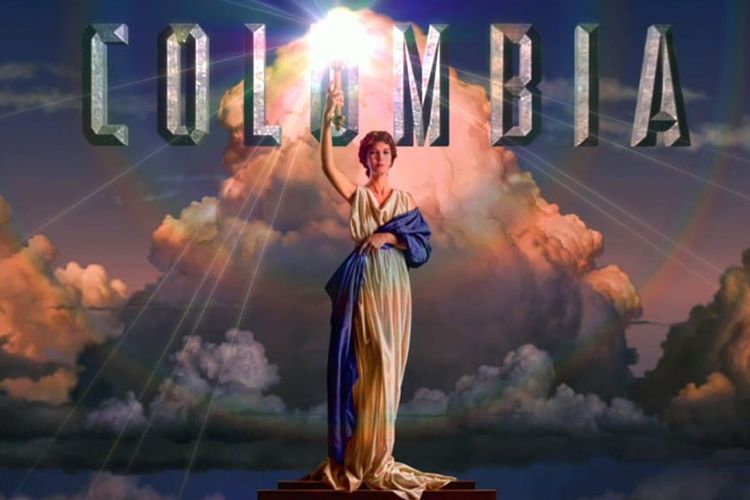Next to the Statue of Liberty, the woman in the Columbia logo is the most recognizable statue in the US. The gorgeous painting depicts a glowing sunset and billowing clouds that surround a beautiful woman. Like that other famous monument, she lifts one arm bearing a torch and wears a flowing robe.
This elegant symbol began as the logo of a low-rent Hollywood studio that grew into a Hollywood juggernaut. The story of this robed figure goes back to the early days of Hollywood.

Early History of Columbia Pictures
In 1918, brothers Jack and Harry Cohn and their friend Joe Brandt founded the Cohn-Brandt-Cohn Studio or CBC. The three men were best friends who had worked in various positions at other studios.
They rented a space on Gower Street in a neighborhood known as “Poverty Row” because it was home to studios that churned out cheaply made, forgettable or “trashy” Hollywood movies. In its early years, CBC seemed to fit that image perfectly. The studio specialized in short, low-budget productions that didn’t aspire to be great artistic or commercial hits. These movies featured vaudeville acts, unknown performers and hastily written scripts.
Looking for an Image Change
In 1924, Brandt left the company. The brothers changed the studio’s name to Columbia Broadcasting Corporation and launched a campaign to improve its image.
As part of this change, the brothers commissioned a new logo. They selected a woman who looked like a goddess or warrior with a shield in one hand and a wheat spike in the other. The name Columbia appeared in a badge over the image. The lady first appeared in the studio’s advertising in 1926.
Who Is Columbia?
Although she is often called the warrior goddess, warrior queen or the torch lady, the figure in the logo actually represents Columbia.
Who is Columbia? Columbia is a fictional woman who represents America. Her name derives from Christopher Columbus. Early explorers referred to America as “Columbia.” Although she’s not that famous now, Columbia first appeared in poems, songs, paintings and statues in the 1700s.
Columbia was the personification of America. She was depicted as a beautiful heroine. The Atlantic magazine once called her “Uncle Sam’s older, classier sister.”
She inspired many songs and many place names, including Columbia University, the District of Columbia and the Columbia River.
Columbia may have been displaced in popularity by Lady Liberty, but she shines on in the CBC logo.
Bringing In the Big Budgets
During this time, the brothers were hoping the logo would preside over a new direction for their studio. They made another smart decision by hiring director Frank Capra. At the time, Capra was unknown. Under his influence, however, the brothers increased the studio’s budgets for scripts and performers. In return, Capra put Columbia on the map.
Capra directed several hit movies for CBC that put the studio’s low-rent image behind forever. Through the late 1920s and 1930s, Capra helped turn Columbia into a major Hollywood studio. The studio released Capra’s hits It Happened One Night in 1934, You Can’t Take It With You in 1938 and Mr. Smith Goes To Washington in 1939. The latter made a star of James Stewart.
Bigger and Brighter
Columbia produced some of the best-known movies in Hollywood, including Born Yesterday, From Here to Eternity, On The Waterfront, Picnic, Lawrence of Arabia, Dr. Strangelove and Fail Safe. The studio also released the classics Guess Who’s Coming to Dinner?, Funny Girl and Taxi Driver.
The Lady Vanishes
In 1933, Columbia scrapped the painting for a simple black and white drawing of the torch-bearing lady.
Over the years, the logo went through many more changes. Some versions featured only the company name. In 1964, the logo was just a drawing of the torch. This was the most simple, stripped-down logo in the company’s history. In 1989, the lady returned, but she remained black and white.
Read more on trademarking a logo.
A Classic Returns
In 1991, the studio decided it needed a new painting of the goddess. Columbia commissioned artist Michael J. Deas to create a new oil painting.
Photographer Kathy Anderson was friends with Deas. He asked her to take the photographs of a model in a draped robe that he could use to develop the painting. In an interview, Anderson described the day of the photo shoot.
Her friend Jenny Joseph, who had never modeled before, was the model for the photo shoot and painting. Deas came to the studio to do the preliminary sketches, and the three worked on the iconic images. Anderson said it didn’t hit her until later what a big deal it was.
“The first time I saw the Torch Lady on the big screen, I was speechless,” she said. “I guess it never sunk in that millions of people would one day see this image.”
It took Deas two months to produce the artwork for Columbia. The beautiful painting Deas created from this shoot is the one that graces the Columbia logo today.
Sale to SONY
The original location of CBC is now the home of Sunset Gower Studios. It is Hollywood’s largest independent studio.
In 1989, CBC was sold to the electronics giant SONY. The low-rent studio started by three Hollywood dreamers is now a major producer of blockbusters and classics. The lady with a torch continues her reign as one of the longest-lasting symbols in Hollywood history.

